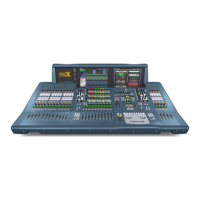• Open the Patching screen and route the aux/matrix from there.
For information on patching, see Patching.
Linking
You can link two mixes together. Pairs can only be created from adjacent mix
buses of the same colour. To link a pair of mix buses, click the LINK button of
either of the mix buses (odd or even) you want to link (see To Select The Mix
Bus Mode).
The linked parameters default to the user-con gurable global default link
settings, which are set via the GUI menu (choose home > Preferences >
Linking). However, you can override these default link settings for the pair
via the Stereo Linking Options window, which is opened by pressing the
LINK OPT. button (to the right of the LINK button).
Using Fader Flip
For information on using fader ip, see Controlling The Mix Buses In
Flip Mode.
NOTE: When using fader ip to control the aux bus levels, always use the
GUI to check the level. This is because the fader level markings have a
maximum of +10 dB, whereas the aux bus levels only go up to +6 dB.
Setting up the e ects rack
The GUI’s E ects screen contains a virtual 24-unit rack. You can have a maximum
of 24 e ects units in the rack, the number being dependent on con guration (via
the E ects and GEQs section of the Preferences screen).
Each unit can contain any combination of the e ects listed in the
Change Device Type window.
The assignable controls panel is common to all e ects, and lets you control
e ect parameters via the equivalent panel on the control surface (master bay).
>> To choose an e ect
1. At the GUI, choose home > Rack Units > E ects. Alternatively, press the
e ects/graphics screen access button in the primary navigation zone.
2. Click within your chosen rack position. This will be the position of the
new e ect.
3. In the e ect window, click CHANGE DEVICE TYPE.
4. In the Change Device Type window, click your chosen device type.
5. Click OK.
6. Change the parameters of the new e ect device as necessary. For example,
adjust control knobs, press buttons etc. You can even change the e ect’s
name by editing its name eld (upper-left corner of e ect window).
7. Click CLOSE to close the e ect window. The new e ect will appear in
the e ects rack. You can now patch the new e ect, which will be on the
E ects tabs of both the From and To sections of the Patching screen.
For information on how to patch, see Patching.
Simple Routing To Master Stereo Outputs
The following shows you how to obtain audio. Before proceeding with this
operation, make sure nothing is muted and master faders are up.
>> To obtain audio
Do one of the following:
• In the primary navigation zone, press the automation/ ling screen
access button.
Managing the shows
The four buttons (NEW, LOAD, SAVE and SAVE AS) towards the top of
Automation screen let you create a new show, load an existing show,
update the current show or create a new show using the current settings.
Important:
We recommend that you save your show settings regularly (see Saving
A Show Versus Storing A Scene). The control centre will indicate that
there are show settings to be saved by changing the background colour
of the SAVE button to red.
>> To create a new show
1. Click NEW.
2. In the Enter new show name: window, type your chosen name for the
new show.
3. Click OK. You can now create and manage the scenes for your new show.
(Clicking CANCEL instead of OK will close the Enter new show name:
window without creating a new show.)
>> To save a show or create a new one from the current settings
Do one of the following:

